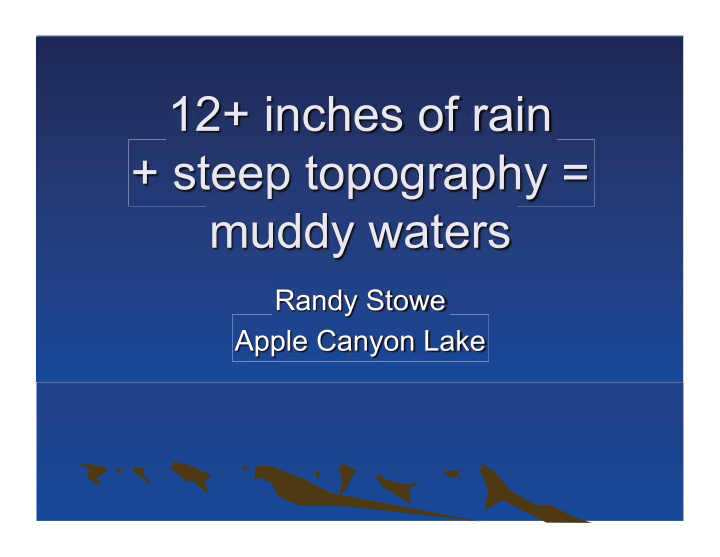



• � Apple Canyon Lake (ACL) was formed in 1969 by damming Hell's Branch, an Apple River tributary in Jo Daviess County. • � The 450 acre lake is the focal point of a 2,700 acre / 2,727 lot recreation-based residential community. • � The balance of the 9,870 acre watershed is dominated by agricultural uses, with cropland comprising 50% of the watershed.
• � Due to the steep watershed topography, watershed cropland erosion is always an issue, but stream channel erosion and incision also causes significant sedimentation within ACL. • � This sedimentation, and associated nutrient load, has resulted in degraded water quality within both Hell’s Branch and ACL.
ACL Watershed Land Cover
• � On July 23 rd , 2010, northwestern Illinois experienced significant rainfall, seemingly centered over ACL, where over 12 inches of rain fell. • � The intense precipitation, combined with the steep watershed topography, caused significant flooding and significant erosion along the streams and drainage ways leading to the lake.
• � The trail system circling ACL was particularly hard hit, with trail surfaces washed away or gullied, and the trail itself washed entirely away at locations where drainage ways crossed the trail. • � Significant damage also occurred to the stream channels themselves, with significant erosion, downcutting, and sediment delivery to the lake.
The ACL trail system is a heavily utilized amenity. Re-opening the trails in a safe condition, and minimizing future channel erosion, was identified as a critical area of focus. ACL Maintenance Crews focused on implementing repairs to the majority of the trail system. A local heavy equipment contractor was brought in to handle the critical area repairs.
• � Much of the most major trail damage occurred where the existing culverts under the trails could not accommodate the flow, forcing the flow over the top of the trail, scouring the trail and the downstream slope. • � Site investigations revealed that insufficient culvert capacity and debris blockage were major factors.
• � After the major trail repairs were conducted in Fall 2010, it was determined that the next ACL focus would be on conducting a drainage study to determine how much watershed area drains to each trail crossing; how much culvert capacity is needed; and how much capacity can be provided at each trail crossing.
LIDAR ( Light Detection And Ranging ) is an optical remote sensing technology that can measure the distance to, or other properties of a target by illuminating the target with light, often using pulses from a laser.
• � Most drainage ways at ACL flow through “greenways”, common open space areas that are typically densely wooded, and contribute a significant woody debris load to the stream corridor, increasing the potential for debris blockages at culvert crossings.
• � For years, it seems to have been assumed that “any” tree is a “good” tree, and the wooded portions of the ACL greenways were left largely unmananged. • � It is now recognized that the dense shade cast by invasive / non-native trees and shrubs can contribute to slope and streambank erosion.
• � Apple Canyon Lake is now moving forward on a watershed planning effort to better identify existing and potential water quality impairments, evaluate and recommend water quality Best Management Practices (BMP’s), and gain stakeholder involvement. • � The plan will be prepared to meet the IEPA/USEPA guidelines for the Section 319 program.
• � Jo Daviess County Soil & Water Conservation District • � Jo Daviess County Conservation Foundation • � ACL Conservation Committee • � ACL Grants Committee • � ACL Trails Commitee
Recommend
More recommend